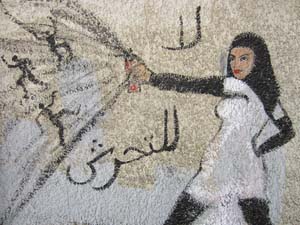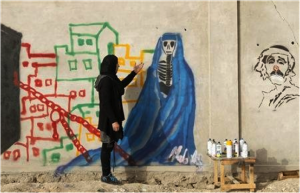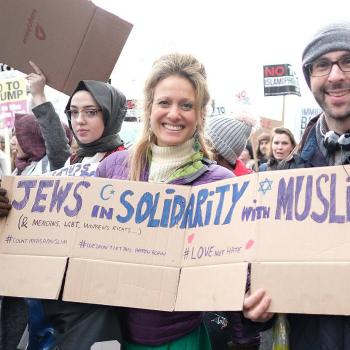When I was a teenager, my dad and I used to enjoy looking at the graffiti painted all over Mexico City. While my dad was a critic of the graffiti that was just scribbles and swear words and obscene signs, we enjoyed those graffitos that were not only truly artistic but also political. Graffiti was, and continues to be, widely spread through Mexico as political and economic turmoil were the themes of the 90s and the early 2000’s.
Graffiti, which remains illegal in most states in Mexico, is a dangerous activity that is associated with “gangs” and mostly men that have “nothing better to do.” Nonetheless, even in my teen years, I saw in many graffiti pieces meaningful lessons of change and hope.
Although I completely acknowledge the challenges that come along with having private property damaged with graffiti and the like, I see graffiti art as a powerful way of expression that resembles that of political cartoons, which I discussed last year. Whereas graffiti has also been used to intimidate others, including Muslim women these days, it has a lot of value when used to deliver positive messages.

Graffiti is not only a medium designed to reach even the most oblivious audiences, but it also infiltrates the political sphere by questioning and mocking authority. The question of whether graffiti is art or just pure vandalism that affects the public interest continues to be debated (for example, here, here and here).
In the past few weeks, Muslim women have appeared in media stories that depict them as rebel agents that are instigating change through graffiti. Not only are these women challenging social expectations by stepping into an all-male dominated sphere, but they are also bringing along strong messages against problems that affect mostly female populations (sexual harassment, rape, political participation, etc.). Women are entering the public sphere, through the artists and through the walls on which women are depicted.
Recently, graffiti artists in Afghanistan and Egypt are being featured in the Western media for their accomplishments in challenging the authorities in their respective countries. For instance, Malina Suliman is said to be one of the few female graffiti artists in “the most dangerous country in the world,” Afghanistan. She teaches, paints and goes out to paint graffiti around the country despite societal restrictions and her family’s opposition. Similarly, the Women on Walls (WOW) organization has draw attention because of their artistic approach in the world of graffiti, which targets women’s difficulties in post-Arab Spring societies.

Some media sources highlight graffiti artists in the Middle Eastern context as agents of change partly because they defy Western views on Muslim women as passive and oppressed. On the one hand, women in hijabs and graffiti are not usually what the Western media expects. On the other, these women have been successful in getting away with drawing in public spaces in what Western media sources consider to be oppressive and more-than-dangerous societies.
Yet, I think that what comes along with Muslim women’s graffiti is not only agency, but also a way to attract attention to a message rather than the messenger. In that regard, Hannah Habibi’s phrase resonates with me:
“I feel that if only the voices of Muslim women were presented a little more by the media, rather than simply being talked about, we would benefit and become a little more understanding of one another.”
And that’s exactly what I feel is missing in the coverage of Muslim female graffiti artists… what are they saying? How? And why? The walls in which these women draw use strong symbolism and messages, giving voice to their feelings. Graffiti, unlike many other forms of art, is not the art of the elite. It often speaks of challenges of ordinary people, faced in this case, by middle-class and lower-class women. It invites the observer or the passerbys to see those challenges
The stories being told on the walls by Muslim women remind me of my teen years, when I easily connected with the words in the walls. Graffiti may be either inviting or repulsive depending on who you are, but you are forced to look at the message.
After reading few stories on Muslim women and graffiti however, I think the question is fair: can we go beyond looking, to really listen to the messages?















